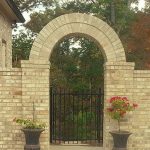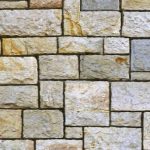Followings are the specification of stone masonry and with Ashlar Masonry is as below:
a) The mortar used in work shall have the strength of not less than 5 N/mm2 or 7.5 N/mm2 at 28 days specified. Mortar shall be fluid, mixed thoroughly and then poured in the joints.
b) All stratified stone possessing bedding planes shall be laid with the natural bed as nearly as possible at right angles to the direction of load. The natural bed shall be radial for use in arch rings.
c) Except for dry rubble walling, all joints shall be sufficiently thick to prevent stone to stone contact and the gap shall be completely filled with mortar.
d) Stones shall be clean and properly wetted before they are used so as to avoid sucking of water from mortar.
e) The bed which is to receive the stone shall be cleaned, wetted and covered with a layer of fresh mortar.
f) All stones shall be laid full in mortar both in bed and vertical joints and settled carefully in place with a wooden mallet
immediately after placement and solidly embedded in a mortar before it has set.
g) Clean and wet chips and spalls shall be wedged into the mortar joints and bed whenever necessary to avoid thick joint or bed of mortar.
h) Dressing of the stones shall be done before they are laid and as per the stipulated requirement.
i) Continuous vertical joints shall be avoided.
j) The verticality of the wall shall be frequently checked with plumb-bob.
k) Through stones shall be used within 1.5 m distance.
l) TI1e height of masonry shall be used uniformly.
m) Under the beams, trusses, sills, etc., large flat stones shall be used.
n) Before continuing work, the masonry built on the previous day shall be well cleaned and freed from loose particles.
o) Curing shall be done properly for 2 to 3 weeks.
p) Masonry shall not be laid when the_eir temperature is less than 3 C. Newly laid masonry shall be protected from the harmful effect of weather.
Use of different stones
a) Granite: It is used in facing work walls, steps, sills, bridge piers, columns, and road metal.
b) Gneiss: It is used in street paving and rough stone masonry wall.
c) Marble: It is used in flooring, steps and ornamental work as it can be carved easily and at the same time, it can take a nice polish.
d) Slate: It is mostly used in roofing work and in sills and damp-proof courses.
e) Quartzite: It is used in retaining walls, road metal, concrete aggregate, pitching rubble masonry and facing of buildings.
f) Sandstone: It is used in facing work, steps, walls, road metal, and ornamental carving.
g) Limestone: It is used in floors, steps, walls, road metal, manufacture of lime in a blast furnace, etc.
h) Basalt and trap: It is used in road metal, for rubble masonry, foundation works, etc.
i) Laterite: It is used as building stone and in road metal and rough stone masonry work.
j) Murum: It is a metamorphic rock, which is brown or red in color. It is used in road metal and garden walls.
k) Chalk: It is pure White limestone which is soft and easy to form a powder. It is used in the manufacture of Portland cement and the penetration of glazier’s putty.


